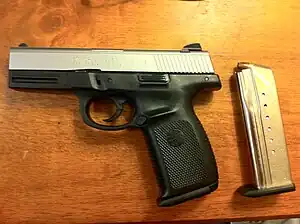| Smith & Wesson SW | |
|---|---|
 S&W SW | |
| Type | Semi-automatic pistol |
| Place of origin | United States |
| Production history | |
| Designer | Smith & Wesson |
| Designed | 1993–1994 |
| Manufacturer | Smith & Wesson |
| Variants | SW40F, SW9F, SW40C, SW9C, SW40V, SW9V, SW40E, SW9E, SW40VE, SW40GVE, SW40Ti, SW357V, SW9VE, SW9P, SW9G, SW380M, SW9M |
| Specifications | |
| Mass | 26 ounces (740 g) (SW40F, SW9F) 24 ounces (690 g) (SW40C, SW40V, SW40VE, SW40E. SW357V) 24+1/2 ounces (700 g) (SW9C, SW9V, SW9VE, SW9E, SW9G, SW9P) 20 ounces (SW40Ti) |
| Length | 7+3/4 inches (197 mm) (SW40F, SW9F) 7+1/4 inches (184 mm) (SW40C, SW40V, SW40VE, SW40E, SW40Ti, SW357V SW9C, SW9V, SW9VE, SW9E, SW9G, SW9P) |
| Barrel length | 4+1/2 inches (114 mm) (SW40F, SW9F) 4 inches (102 mm) (SW40C, SW40V, SW40VE, SW40E, SW357V, SW9C, SW9V, SW9VE, SW9E, SW9G, SW9P) |
| Width | 1+1/3 inches (33 mm) |
| Height | 5+1/2 inches (142 mm) (SW40F, SW9F) |
| Cartridge | .40 S&W .357 SIG 9×19mm Parabellum .380 ACP (SW380M) |
| Action | Short recoil |
| Feed system | Detachable box magazine; capacities:
|
| Sights | Fixed 3-dot notch sights |
The Smith & Wesson Sigma was Smith & Wesson's first venture into using synthetic materials in pistol construction, with high-strength polymer material for the frame. The pistol is similar to a Glock safe-action pistol in both its design and operation, leading to controversy and speculation regarding patents infringement.
The Sigma line was replaced by the Smith & Wesson SD series in 2010.
Description
Created in 1994, the Sigma incorporates a pre-set striker firing mechanism. It is available in both .40 S&W cartridge and 9×19mm Parabellum, being one of the first pistols purpose-designed to handle the .40 S&W. Similarly styled sub-compact designs in .380 ACP and 9×19mm were also produced. A limited number of these pistols were also chambered in .357 SIG.[1] The .380 ACP version bore visual similarities to the larger Sigma pistols, but used a direct-blowback operating system and was otherwise unrelated. The material used for the slide in the .380 ACP pistols is a zinc-aluminum alloy known as ZAMAK.[2] The guns chambered in 9x19 Parabellum, .357 SIG and .40 S&W used steel slides and were all locked breech firearms using the short recoil system developed by John Browning.
History and Design Changes
"Gen 1"
In 1994, S&W introduced the original Sigmas, the SW40F and SW9F chambered in .40 S&W and 9mm Luger respectively. Both were full sized models as denoted by the letter F. Both had black polymer frame and a dark blued slide. Both had "double stack" magazines with a capacity of 15 and 17 rounds respectively. It had the same grip angle as the Colt 1911A1.
Soon after, S&W introduced a pair of very small concealed carry–style variants, the SW380M and the SW9M, chambered in .380 ACP and 9mm Luger respectively. Both had a black polymer frame and a dark blued slide. Both had rudimentary sights. Both utilized a "single stack" magazine and had a large thumb cut-out to make removal of the magazine easier. The SW9M had a magazine capacity of seven rounds. The significantly smaller SW380M had a magazine capacity of six rounds.
The next incarnation of the Sigma were models limited to 10 rounds due to the 1994 Assault Weapons Ban. Smith & Wesson significantly dropped the price and changed the polymer frame color to light grey with matching slide. The model designation of these pistols were SW40V and SW9V, with V being equated with Value. Later, V models were introduced with black polymer frame and stainless steel slides.
Simultaneously, S&W introduced the SW40C and SW9C. This version of Sigma retained the black polymer frame and black slide of the original SW40F and SW9F. These models had the Double Action Only trigger. This was a feature marketed heavily to police departments especially those transitioning from revolver to semi-automatic pistol as the trigger pull was the same for each shot. Also, the trigger pull was long and heavy similar to a double-action revolver which was believed to reduce the chance of inadvertently firing the pistol. This model was almost exclusively marketed to police departments. Used models can be found with standard capacity magazines even though most pistols produced during this period were restricted to 10 rounds. This is because police departments were exempt from the 10-round limit. After the ban on high-capacity magazines ended, departments could legally sell both pistol and standard capacity magazine on the secondary market.
"Gen 2"
In 1999, S&W introduced the VE series. These models were billed as "enhanced" and featured an improved grip, improved trigger, and enlarged ejection port. This model returned to the black coloration of the polymer frame mated with a stainless steel or black melonite slide.
At this time, S&W retired the 4.5 inch barrel and switched all Sigmas to the 4.0 inch barrel. Sigmas from this era onward are considered "2nd generation" Sigmas. Shortly after the introduction of the VE series, Smith & Wesson further improved it by adding an accessory rail but did not change the model number to reflect this update.
Sometime after 1999, S&W introduced the SW40P and SW9P. These models were identical to the SW40VE and SW9VE but added porting to the barrel and slide, the purpose of which was to vent gases upwards to fight the muzzle flip associated with recoil.
In 2010, S&W replaced the Sigma pistols with the SD series, which uses the same magazines as their full size Sigma counterparts.
Patent issue
The Sigma series pistols were so similar to the competing Glock pistols that Glock sued Smith & Wesson for patent infringement. The case was settled out of court in 1997, with S&W agreeing to make alterations to the Sigma design and pay an undisclosed amount to Glock.[3]
Former users
 Afghanistan: Afghan National Army, Border patrol and police (22,000+ handguns)[4]
Afghanistan: Afghan National Army, Border patrol and police (22,000+ handguns)[4].svg.png.webp) Australia: Western Australia Police[5]
Australia: Western Australia Police[5] United States: Tennessee State Parks (Park Rangers were issued .40 S&W with custom logo on the hand grip) (300+handguns)[6]
United States: Tennessee State Parks (Park Rangers were issued .40 S&W with custom logo on the hand grip) (300+handguns)[6]
See also
References
- ↑ Boorman, Dean K. (1 December 2002). The History of Smith & Wesson Firearms. Globe Pequot Press. p. 75. ISBN 978-1-58574-721-4.
- ↑ "SW380 - Forgotten Pocket Gun That Should Stay Thataway". 3 April 2019.
- ↑ Judge dismisses lawsuit against gunmaker, S&W and Glock settle suit | Shooting Industry | Find Articles at BNET
- ↑ Guns and Ammo, Stan Trzoniec, October 2010
- ↑ "Old Hansard". Archived from the original on 19 January 2019. Retrieved 11 April 2017.
- ↑ TN.gov